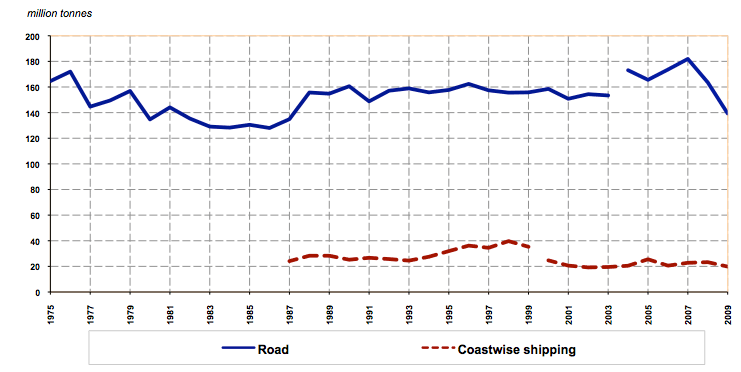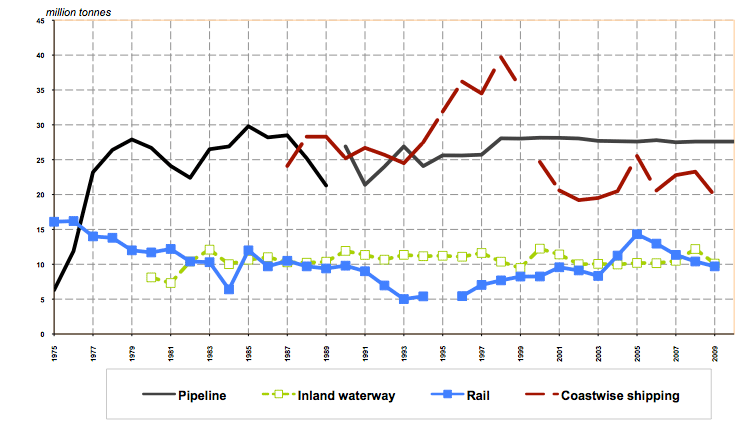Transport and Travel in Scotland 2010
Summarises a broad range of transport statistics including road vehicles, traffic, casualties, bus and rail passengers, road and rail freight, air and water transport and personal travel as well as providing some comparisons with GB figures. Further breakdowns of Scottish Household Survey transport data including households' access to cars and bikes, frequency of driving, modes of travel to work and school, use and opinions of public transport and access to services are also presented.
8 Freight
- Two thirds of freight lifted in Scotland is transported by road (A slight fall from a peak of 71% in 2007). Five per cent is carried by rail, 13 per cent by pipeline and the rest by water. These proportions have changed little over the last ten years.
- There were 139 million tonnes of freight lifted by road in Scotland in 2009.
- Twenty million tonnes of coastwise freight traffic was lifted in Scotland in 2009.
- Twenty-eight million tonnes of oil were transferred by pipeline in 2009 continuing the trend levels.
Road
8.1 There were 139 million tonnes of freight lifted by road in Scotland in 2009. (Caution is advised when comparing with figures prior to 2004-05 as the DfT's improved the survey methodology and processing. Prior to that, there had been little change from year to year in the ten years up to 2003.)
8.2 The 2009 figure continues a fall from a peak of 182 million tonnes in 2007. Over the longer-term, the amount of freight carried by road fluctuated between 1975 and 1987 (see Figure 26), rising to 172 million tonnes in 1976 and falling to 128 million tonnes in 1986. After 1988, it was more stable, varying between 149 million tonnes (in 1991) and 162 million tonnes (in 1996). Figures 26 and 27 show that, in terms of tonnes lifted, much more freight is carried by road than by any other mode of transport. Per head of population, the amount of freight which is lifted by road is slightly higher in Scotland than in Great Britain.
Rail
8.3 The volume of rail freight traffic lifted in Scotland fell from 29.8 million tonnes in 1960 to 5.4 million tonnes in 1994-95. Figure 27 shows that since then it increased to a peak of 14 million tonnes in 2005-06 before falling back again to just under 10 million tonnes in 2009-10.
Coastal
8.4 Since 2000, levels of Coastwise freight traffic lifted in Scotland have fluctuated between 20 and 25 million tonnes and were at 20 million tonnes in 2009. The figures from 2000 are on a different basis from those for earlier years (Chapter 10 of Scottish Transport Statistics explains this in more detail).
Inland Waterways
8.5 The annual amount of freight lifted for inland waterways has remained between about 9 and 12 million tonnes since 1982. Figure 27 shows the trends since 1980 (inland waterway) and 1987 (coastwise traffic). Per head of population, much more freight is lifted by coastwise shipping in Scotland than in Great Britain.
Pipelines
8.6 The amount of oil carried in Scottish pipelines rose rapidly to 28 million tonnes in 1979, and has remained at 28 million tonnes over the last ten years. Figure 27 shows the trends since 1975. Per head of population, the amount of freight which is lifted by pipeline is significantly greater in Scotland than in Great Britain.
Freight moved - tonne-kilometres
8.7 Figures 26 and 27 showed that, in terms of tonnes lifted, more freight is carried by road than by any other mode of transport. However, a different picture can be seen when account is taken of the distance that freight is carried. Table H2(b) shows that, in terms of tonne-kilometres, coastwise shipping accounted for the largest amount of freight moved in most years, with road coming second (in 2004 the position was reversed). Rail and pipeline still move smaller amounts of freight than road. However, they represent a higher proportion of the total when they are measured in tonne-kilometres, because of the greater distance (on average) for which freight is carried by rail and by pipeline.
Figure 26: Freight lifted: road and coastwise shipping

NB: breaks appear in the series due to changes in the survey methodology and processing.
Figure 27: Freight lifted: coastwise shipping, pipelines, inland waterway and rail

NB: breaks appear in the series due to changes in the survey methodology and processing. The increase in pipeline figures between 1989 and 1990 is believed to be due to a change in coverage.
There is a problem
Thanks for your feedback